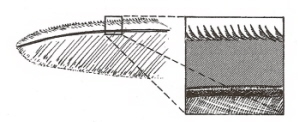Bats aren’t the only aerial predator of night. Owls with their stealth abilities and quick moves dominate the night. Owls are known as the most silent flying animal. How do owls approach their prey so fast without being noticed?
Can we take their solution of silence and apply it to our aircraft?
Unlike wings of other birds, most owl species’ wings are serrated on the leading edge. The serrations give the owl a better ability to control airflow, therefore allowing owl to fly faster and to reduce noise.1
The serrations helps owl to divide the main airflow into several smaller airflows. When an object moves through a fluid, such as air, it creates a disturbance in that fluid, called turbulence.2
This disturbance in the air, as it travels and hits our ears, is what we hear from a flying airplane or a bird. However when the turbulence itself isn’t so chaotic and strong, the noise we hear is less.
Nature’s solution for owls is having -so to say- several tips (serrations) on their wings, therefore creating several microturbulences instead of one strong turbulence,3 therefore the noise heard is much less.
Of course the secret of silence isn’t just limited to serrations. Airflow passing through the wing’s leading edge, hits the velvety feathers which absorb the vibrations in air therefore even reducing the noise created by flight of owl further.4
Owl’s secret is basicly letting the air pass through without disruption as much as possible, therefore creating less vibrations which traverse through the air and hit its prey’s ears and register as noise.
We can harness this feature by creating similar serrations on our wings and rotor blades. Ziehl-Abegg, Inc., primarily a ventilator company, has designed axial fans taking serrated owl wings as an example.5
Sources
- The three-dimensional shape of serrations at barn owl wings: towards a typical natural serration as a role model for biomimetic applications
- Wikipedia – Turbulence
- NASA Technical Memorandum – Aerodynamic Effects of Leading-Edge Serrations on A Two-Dimensional Airfoil
- HowStuffWorks – How Owl Feathers Work
- Ask Nature – Fe2 Owlet Axial Fan







One Comment
Lorena Barba posted on October 10, 2012 at 9:00 pm
I wonder if the serrated leading edge is a feature that only owls have.
Here is a video showing some German scientists who studied owls’ wings to try to understand why they are so quiet and what they could learn from owls to make airplanes quieter:
http://youtu.be/Xn3t1xiL3sc